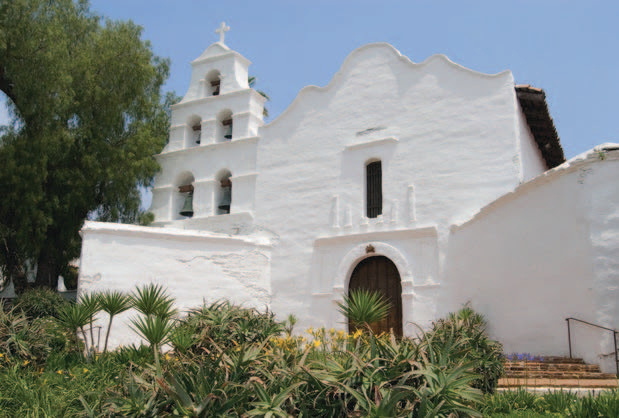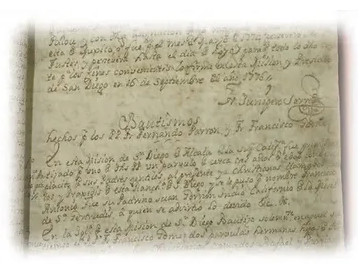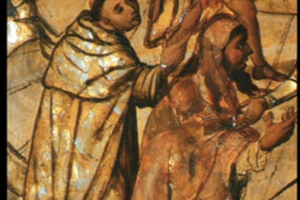Exerpt from Catholic Textbook Project; From Sea to Shining Sea textbook —Day after day, for nine days, the small man in a gray habit climbed to the summit of the little hill and looked anxiously out to sea. Day after day, he had been disappointed. Below him lay the bay like a long finger of water thrust into the land. Beyond the bay lay the sea; nothing but the sea. No sails could he see coming up over the horizon, no ship sailing into harbor. Nothing but the deep, blue sea.
Fr. Serra’s desperate novena to St. Joseph
Fray Junípero Serra, the small man in gray, desperately wanted to see a ship. Without the supplies of food the ship would bring, the new settlement of San Diego, with its mission, could not survive.

Don Gaspar de Portolá, commander of the Spanish troops in San Diego, had told Fray Junípero that the settlement had to be abandoned. But Fray Junípero asked Portolá to wait only nine more days, until March 19, the feast of St. Joseph. Fray Junípero said he would pray a novena prayer to St. Joseph; if no supplies came by St. Joseph’s day, the friar said he would agree to leave San Diego.
St. Serra’s journey to “Alta California”
Twenty years earlier, in 1749, Junípero Serra had left his home on the island of Majorca in the Mediterranean to serve as a missionary in Mexico. With his fellow Franciscans, Fray Junípero had worked among pagan Indians in the Sierra Gorda region, 175 miles north of Mexico City. In 1767, he became the father-president of the Franciscan missions in Baja California.
Two years later, Fray Junípero joined Portolá in an expedition into Alta California, as the modern state of California was then called. Spain had discovered Alta California more than 200 years before but had never settled it. Spain wanted to settle it now, chiefly because of Russia.
Spain feared Russian expansion
For a long time, Russia had been expanding eastward across Asia, and by 1741 the Russians had explored the Bering Strait and crossed over into Alaska.
Discovering that America was rich in furs, Russian adventurers were exploring the northwest coast of the continent and were pushing steadily southward—toward Alta California. Spain saw that it might lose upper California if no Spanish settlements were established there. So Portolá led a military force northward, both to protect Fray Junípero and the Franciscans, and to save Alta California for Spain.
Travel was extremely difficult for Fr. Serra

The journey north had been difficult for Fray Junípero. When he first came to Mexico, he injured his leg and the wound never healed. The journey into California was long and difficult. Fray Junípero’s leg swelled and gave him continuous pain.
But so great was his desire to bring the Gospel to the Indians of Alta California that Serra would not be left behind. Despite the great pain in his leg, the friar continued the long journey into the north.
Problems in San Diego
Serra had stayed at San Diego, the first Spanish settlement in California, while Portolá continued his exploration to the north.
Things had not gone well at the settlement during the six months Portolá was away. The expected supply ship had not arrived. Fray Junípero had made no converts.
The Indians were unfriendly. They stole from the Spanish camp and even tore strips of cloth from the sails on the Spanish ships. When the Spanish fought back, the Indians attacked them with arrows, killing some of the settlers.
When he returned in January 1770, Portolá saw how badly off the settlement was. He was certain it could not continue.
What must Fray Junípero have thought when, climbing the hill on the morning of the last day of his novena, he saw no ship? It was now St. Joseph’s day, and it seemed the saint had not answered Junípero’s prayers. Fr. Serra descended the hill, probably with heavy heart that he must abandon California.
But the day had not ended.
That afternoon, someone sighted a ship under full sail. It was the San Antonio, coming from Mexico with supplies for the San Diego settlement. St. Joseph had answered Fray Junípero’s prayers after all!
Hauntingly Beautiful Lamentations from Mexico City
When in Mexico City, Fray Junípero Serra may have heard the church music composed by the Mexican-born priest, Manuel de Zumaya (ca. 1678-1756). Zumaya’s church music followed traditional Spanish style, but other compositions, including an opera, La parténope, were influenced by the Italian opera of the time. Zumaya’s was not only the first American opera by an American, but he himself was the first native-born chapel master for the cathedral in Mexico City. Here, in the spirit of Lent, is an excerpt from his Hieremiae Prophetae Lamentationes (Lamentations of the Prophet Jeremiah).
RELATED RESOURCES:
- Catholic Textbook Project
- From Sea to Shining Sea textbook, Catholic Textbook Project





You must be logged in to post a comment.